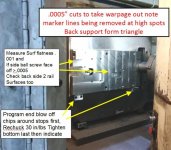Johnny SolidWorks
Hot Rolled
- Joined
- Apr 2, 2013
- Location
- Rochester
Hey gang, I know it's kind of a general question, but I did search the forum a bit before posting this, so bear with me.
I'm looking at used VMCs from a couple of different brokers, and one guy happened to say: "Hey, would you be interested in a Horizontal instead? It's got more HP, more RPM, twice the tool pockets, 50 Taper, and it comes with 3 pallets and a pallet changer."
So of course I say: "How much?"
I kind of blinked at his answer: for a machine from a similar year and manufacturer quality to what I was looking at, the horizontal was only a couple of bucks more than the VMC, which, on paper, looks like about half as much machine.
So I got suspicious, figured this was a lemon, and looked around to see if the price was ridiculous. It wasn't - this seemed to be the case across the board.
So I've got to ask all the much better informed than me PM members: what's the deal with horizontal machining centers that makes them so much cheaper on the used market than verticals? Are guys just not used to them? Are they a nightmare to run? Because 60 tools, 50 HP, 50 Taper with a pallet changer sounds like a dream...on paper. Right?
I'm looking at used VMCs from a couple of different brokers, and one guy happened to say: "Hey, would you be interested in a Horizontal instead? It's got more HP, more RPM, twice the tool pockets, 50 Taper, and it comes with 3 pallets and a pallet changer."
So of course I say: "How much?"
I kind of blinked at his answer: for a machine from a similar year and manufacturer quality to what I was looking at, the horizontal was only a couple of bucks more than the VMC, which, on paper, looks like about half as much machine.
So I got suspicious, figured this was a lemon, and looked around to see if the price was ridiculous. It wasn't - this seemed to be the case across the board.
So I've got to ask all the much better informed than me PM members: what's the deal with horizontal machining centers that makes them so much cheaper on the used market than verticals? Are guys just not used to them? Are they a nightmare to run? Because 60 tools, 50 HP, 50 Taper with a pallet changer sounds like a dream...on paper. Right?




